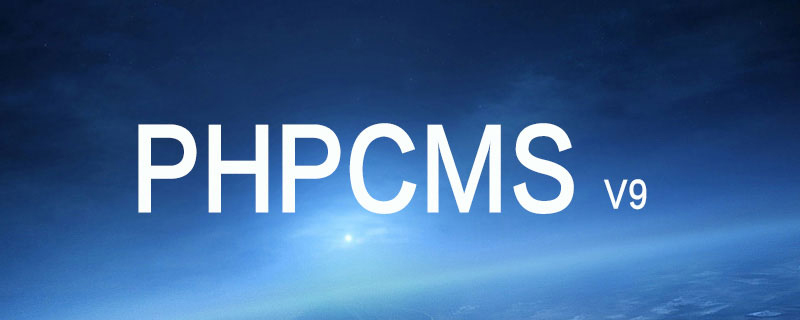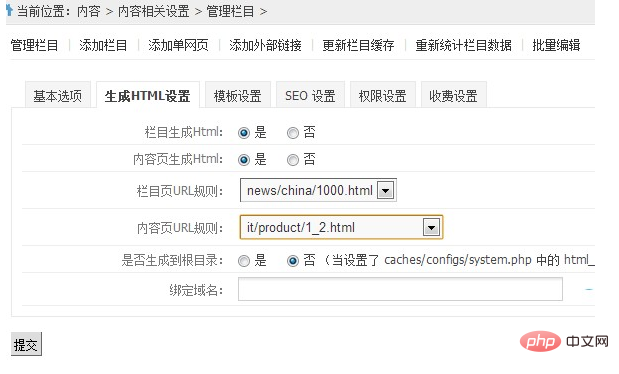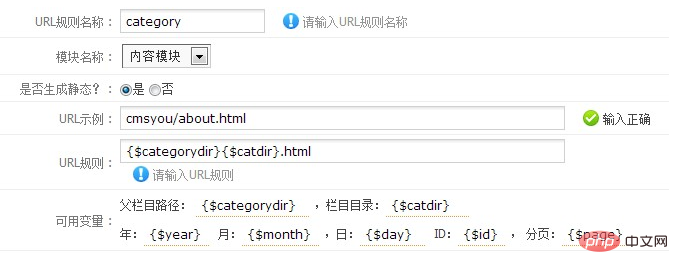

How to generate static pages in phpcms v9?
Recently, when a customer was optimizing their website, they asked specifically about how to make Phpcms V9 static and pseudo-static. CMSYOU remembered that she had shared "Phpcms custom URL rule skills" before. But that is just a principle. Today, I will share with you the actual operation method from the perspective of use.
Related recommendations:phpcms tutorial
Let’s first talk about how to set up Phpcms V9 to generate static HTML in the background, and then explain how to customize URL rules and optimize URL addresses. . In this article, pseudo-static will not be covered. You can move to Phpcms V9 full-site pseudo-static setting method.
1. Static HTML generation settings
Enter PHPCMS V9 background settings, find the classification column, location: Content->Management Column->Add Column (or Manage columns, click "Modify" in the corresponding column):

Pay attention to setting the second tab, "Generate HTML Settings", specific screenshot:

After confirming the submission, remember to update the column cache, and then perform release management: batch update column pages and batch update content pages.
2. PHPCMS V9 custom URL rules and URL address optimization
First understand the html generation principle of PC v9:
Static generated by Phpcms Page directory rules are generated according to URL rules. Static page content is phpcms\templates\default generated by ob_clean front-end template file. Static page debugging: modify the static page, regenerate the static page and see the effect. You can also call front-end control/index .php?m=openservice&c=index&a=openservice Modify the front-end template and then generate it.
As long as there are links to static pages, the files must be synchronized in time to prevent dead links and data errors.
Based on this, we can customize URL generation rules in the background extended URL rule management, specific location: Extensions > URL Rule Management.
1. The default column generation rule is:
{$categorydir}{$catdir}/index.html|{$categorydir}{$catdir}/{$page}.html
When specifically generating html, it will be displayed as: news/cmsyou/1000.html.
This is a bit of a problem. If the list has multiple pages, then the second page will only generate a number of html. For example, 2.html represents the second page of the list. CMSYOU recommends changing it to:
{$categorydir}{$catdir}/index.html|{$categorydir}{$catdir}/index_{$page}.html
Generated according to the column index page, the column list becomes: index.html, index_2.html, index_3.html... This is more clear.
If you want to customize the generation to a fixed directory, you can add a specific English directory in front.
2. The default generation rule for article pages is:
{$year}/{$catdir}_{$month}{$day}/{$id}.html|{$year}/{$catdir}_{$month}{$day}/{$id}_{$page}.html
or:
{$categorydir}{$catdir}/{$year}/{$month}{$day}/{$id}.html|{$categorydir}{$catdir}/{$year}/{$month}{$day}/{$id}_{$page}.html
The HTML web page directory generated by such a rule is too deep. CMSYOU recommends changing it to:
{$categorydir}{$catdir}/{$id}.html|{$categorydir}{$catdir}/{$id}_{$page}.html
The HTML static files generated in this way are only at the root of the column, which is easy to manage and is also beneficial to SEO. For example, http://www.cmsyou.com/support/84.html is an article under the CMSYOU help article. If you remove the 84.html at the end, it will be the home page of the column, so it is straightforward.
3. Optimization of single page generation rules
There is only one default single page generation method. CMSYOU recommends adding one:
{$categorydir}{$catdir}.html
So the single page of the secondary directory can only be Generate an html instead of a directory, which is beneficial to the HTML structure. Share settings screenshot:

In this way, after sharing the specific generation rules and optimization examples of Phpcms V9’s columns, inner pages, and single pages, have you understood the custom HTML generation? rule?
The above is the detailed content of How to generate static pages in phpcms v9. For more information, please follow other related articles on the PHP Chinese website!